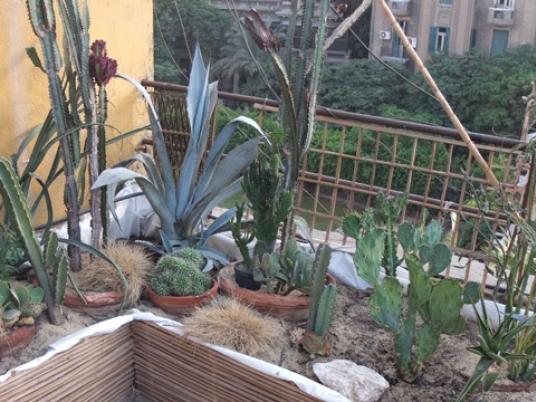
Egypt’s capital spreads cement tentacles over what used to be extremely viable agricultural land, replacing it with rickety brick towers. North and south, east and west, as far as the eye can see, Cairo is an immensity of grey, dotted with millions of satellite dishes planted on derelict rooftops that compete for space with three-legged chairs, dust-layered plastic bags and koshary containers.
But a quiet revolution is on the way to turn these derelict roofs into vegetable gardens, blooming with arugula, tomatoes, herbs and more. Osama al-Beheiry, a professor at the Faculty of Agriculture at Ain Shams University, and Aurelia Weintz from Nawaya, a social enterprise focused on providing a platform for agriculture extension and community, are both specialists on — and developers of — rooftop gardens.
They believe that rooftop gardening and small-scale agriculture is the best way for Cairo to keep from drowning in pollution, while cooling off buildings and providing a secondary source of revenue for families and an input of healthy organic vegetables. Both specialists explain to Egypt Independent how to start a rooftop garden, step by step.
No matter how large the rooftop or the balcony, both experts recommend starting small and gradually expanding, based on the gardener’s experience. “You can grow vegetables on one square meter only,” explains Beheiry, who has launched an awareness campaign funded by the government to develop micro gardens on the rooftops of 75 schools.
“No matter how big your rooftop is, make sure that the garden won’t cover over 60 percent of the space, in order to be able to nurture your plants comfortably,” he recommends. “To grow leafy crops, you need a container 10 centimeters deep. For tomatoes and cantaloupes, the container should be around 25 centimeters deep.”
Just like Beheiry, Weintz is convinced that the best way to do it is to start small.

“Get 10 containers and start experimenting, and in all cases, keep in mind that this garden should be a source of joy, not worry,” she says.
Containers for this type of micro garden can range from plastic bags, plastic bottles, crates, buckets, barrels, tires and clay pots. One can order clay pots from any plant nursery in Cairo and sustain the local economy, according to Weintz. These nurseries are also the best location to purchase seedlings of whatever plant you want to grow.
For those who are tempted to start from scratch with seeds, they can be found in the neighborhood called Bab al-Khalq, squeezed between Al-Azhar Park and Darb al-Ahmar. “You can find all sorts of seeds there, from flowers to vegetables, but those are all imported from Europe,” says Beheiry. As Weintz points out, it is almost impossible to find organic seeds native to Egypt on the domestic market.
A native seed or plant is one that has been growing in a specific place for a very long time and that has not been brought from abroad. As such, it has the capacity to withhold the particular environment’s traits, be it soil, temperature, or even pests.
“Because of industrialized agriculture and its monoculture, seeds have become standardized, and native seeds, which don’t produce the perfect looking fruit or vegetable like the standardized seed, are gradually disappearing,” Weintz explains.
The imported seeds that flood the market are foreign to their new environment and thus weaker, that’s the reason why they need to be sprayed with pesticides and fertilizers to survive and grow. Native seeds, which are almost impossible to purchase because of their rarity, can still be found in remote farms where the farmers have continued growing the same seeds for generations. “But these farmers do not realize how precious these seeds are, unfortunately,” says Weintz.
Bab al-Khalq, apart from Dutch, German and French seeds, also sells garden tools like spades, hand forks, trowels, hoses, and watering cans, drip irrigation systems, and small water pumps, according to Beheiry. This is also where one can find peat moss, an accumulation of partially decayed mosses that grow in wet places. Peat moss, sold LE180 for 100 kilograms in Bab al-Khalq, is a fundamental component of rooftop gardening. It has the ability to retain moisture in the soil when it is dry and prevent excess water from killing roots when it is wet. When mixed with sand, it makes good soil for potted plants and vegetables, although it cannot replace the quality, efficiency or sustainability of homemade compost, according to Aurelia.
“I admit that making compost rather than buying ready-to-use soil and nutrients can be a bit of a burden,” she says, “but what is amazing about compost is that it provides good-quality soil, as well as a natural fertilizer.” The normal decomposition process to make compost usually takes about a month. When compost is ready, it has to be mixed with sand and a bit of the old soil to lower the presence of nitrogen.
There is also another type of compost that is handier for rooftop gardens (as it does not exhale unpleasant scents) called the Bokashi bin. This Japanese fermentation technique uses a mixture of bacteria, fungi and yeast to safely compost the kitchen food scraps — including meat, fish and vegetable waste.
Some vegetables are easier to grow and nurture than others. Leafy crops like lettuce, arugula and spinach are the easiest crops for beginners. Experts say they are very easy to handle and grow in large amounts. According to Beheiry, “A single square meter of lettuce can produce up to a hundred bunches in three weeks.” What’s also important to keep in mind is that these are the crops that suffer the most from the abuse of fertilizers like pesticides and fungicides, so growing them at home makes them safer to eat.

For plants that require a bit more experience and a green thumb, like the tomato, Aurelia recommends buying tomato seedlings first, and then collecting their seeds to try growing them from scratch.
Tending to a rooftop or balcony garden is not very time consuming, but nurturing should be done daily. “You need to work in your garden 20 minutes in the morning and 20 minutes in the evening, and always water your plants at night so the pots can retain the humidity for longer.” Weintz insists on using a mulch such as rice straw to line the tops of the containers and provide a very efficient barrier to evaporation. “Many farms want to get rid of their rice straw, so you can buy it very cheap and contribute to a healthy environment.” Indeed, every year in the fall, Egyptian farmers burn rice straw and create a huge cloud of pollution that hovers over Cairo for weeks.
If these gardens multiply enough, as the trend indicates, they will bring about many benefits for city dwellers. The plants absorb carbon dioxide in the atmosphere and create oxygen. According to Beheiry, one and a half square meters of uncut grass provides enough oxygen for a human for a year. He adds that a rooftop garden cuts down on electricity bills by cooling the building through providing shade and natural insulation, which reduces the use of air conditioners.
In order to train budding gardeners, Weintz’s NGO, Nawaya, organizes the Easy Urban Kitchen Garden Workshop to learn the basics of how to become an urban farmer and set up an edible rooftop garden. The team shows how to retrofit an existing rooftop design, set up a barrel garden and make compost in urban areas. They plan to hold another workshop on the subject as soon as a suitable rooftop is found.
This piece was originally published in Egypt Independent's weekly print edition.




